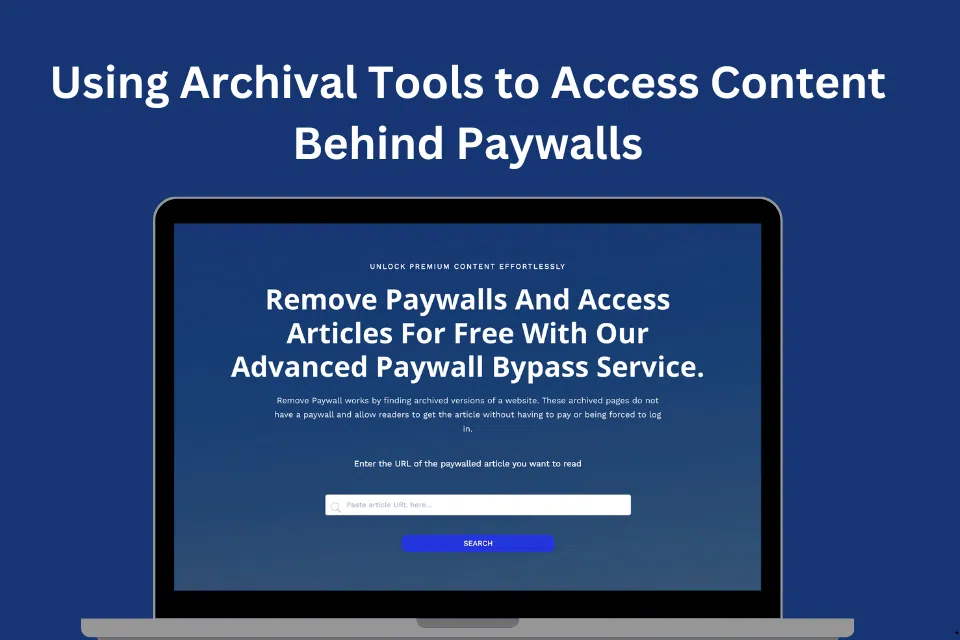Effective Strategies to Access Restricted Content
Accessing content behind paywalls or paid subscription barriers can be challenging, especially for those seeking free or alternative information sources. With the rise of digital media, many publishers have implemented paywalls to sustain their operations. However, there are various methods individuals can use to access these articles without subscribing. We will explore effective techniques to access content behind paywalls and paid subscriptions.
How to Access Articles
Understanding Different Types of Paywalls
Paywalls serve as digital barriers to restrict access to online content, typically implemented by publishers to generate revenue. These barriers come in various forms, including soft paywalls, which allow limited free access before requiring a subscription, and hard paywalls, which block all access unless the user subscribes. Understanding how paywalls work is crucial in finding methods to bypass them effectively. By familiarizing themselves with the type of paywall in place, users can tailor their approach to accessing the content they need. Soft paywalls often reset after a certain period or limit the number of articles one can view, whereas hard paywalls offer no free content.
Utilizing Browser Extensions and Add-Ons
Browser extensions and add-ons are popular tools for bypassing paywalls. These software tools integrate with web browsers to modify or enhance the browsing experience. Some extensions specifically target paywalls by disabling scripts that enforce content restrictions. For instance, extensions like “Bypass Paywalls” for Chrome and Firefox disable the scripts that detect whether a user is a subscriber, allowing free access to the content. However, using such tools responsibly and understanding the legal implications is essential, as some publishers strictly prohibit bypassing their paywalls.
Exploring Archived Versions of Web Pages
Archived versions of web pages offer another effective method to access content behind paywalls. Websites like the Wayback Machine or Archive.ph store snapshots of web pages can be accessed even if the original content is behind a paywall. Users can often find and read the full content by searching for the URL of the paywalled article in these archives. This method leverages the internet’s ability to store information over time, making it accessible even after changes like implementing a paywall. It’s a valuable tool for researchers and casual readers, ensuring that information remains available regardless of paywall restrictions.
Using Browser Features: Reader Mode and Incognito Browsing
Modern web browsers have features like Reader Mode, which simplifies web pages by stripping away unnecessary elements such as ads, sidebars, and sometimes even paywall scripts. By activating Reader Mode, users can often bypass soft paywalls and read the content without interruptions. Additionally, browsers have incognito or private browsing modes, which can be used to reset article view limits imposed by soft paywalls. Combining these browser features can provide a straightforward way to access content that would otherwise be restricted.
How to Access Articles for Free
Leveraging Institutional Subscriptions
Institutions such as universities, public libraries, and workplaces often subscribe to various publications and databases, providing members free access to content behind paywalls. If you are affiliated with such an institution, you can use your membership or student ID to log in and access the needed articles. Many libraries also offer remote access to their digital resources, allowing users to log in from home. This method is highly effective and legal, utilizing the institution’s existing subscriptions and access rights.
Seeking Out Free Trials and Promotions
While bypassing paywalls can be useful, it’s also worth considering free alternatives to paid content. Many publishers offer limited-time free trials or special promotions that provide temporary access to their content. Additionally, some websites aggregate and summarize news from various sources, providing a broader perspective without requiring multiple subscriptions. Services like Google News, Feedly, and other news aggregators can help users stay informed without paying for individual subscriptions. By seeking out these alternatives, users can still access valuable information without violating terms of service or legal agreements.
Utilizing Social Media and Online Communities
Social media platforms and online communities can be valuable resources for accessing content behind paywalls. Authors and publishers often share their articles on platforms like Twitter, Facebook, and LinkedIn, sometimes providing free access to their followers. Additionally, online forums and discussion boards like Reddit frequently have users sharing links or copies of paywalled articles. Engaging with these communities can provide access to content while fostering discussions and connections with others with similar interests. It’s a communal approach that leverages the power of social networks to distribute information widely.
Employing Proxy Servers and VPNs
Proxy servers and virtual private networks (VPNs) can also help bypass paywalls by masking your IP address and location. Some paywalls restrict access based on geographic location, and a proxy or VPN can help you appear to be browsing from a different region. This can be useful for accessing content freely available in certain countries but restricted elsewhere. However, using these tools ethically and being aware of the legal and privacy implications is important. VPNs and proxies should be used responsibly, ensuring that personal data and online activity remain secure.
Using Our Tool
Another effective method to access paywalled content is through our tool available here on our website. Our service allows users to find archived versions of articles that are typically behind paywalls, providing free access to the content. By simply entering the URL of the desired article, users can access its archived version without any subscription or login requirements. Our tool offers a seamless and user-friendly way to bypass paywalls, ensuring that valuable information remains accessible to all.
Conclusion
Accessing content behind paywalls and paid subscriptions can be achieved through various methods, each with its advantages and considerations. There are multiple ways to obtain the information you need, from using browser extensions and archived web pages to leveraging institutional access and seeking free alternatives. Social media, online communities, proxy servers, and VPNs offer additional avenues for accessing restricted content. By understanding the mechanisms of paywalls and utilizing these strategies responsibly, users can stay informed and access valuable content without necessarily subscribing to multiple services.





